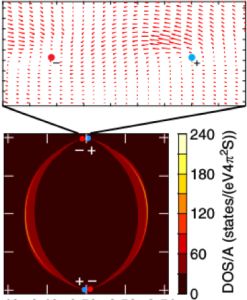Spin-orbit effects in defective van der Waals heterostructures
Spin-orbit effects in defective van der Waals heterostructures
Research questions:
There are a category of very promising 2D materials potentially exploitable in nanoelectronics, spintronics and valleytronics. Many of the interesting properties of TMDs arise from the strong spin-orbit coupling [1] which causes (controllable) splitting in the electronic bands [2] and can lead to the formation of non-collinear spin textures and topological phases [3, 4]. TMDs can contain different types of structural defects which significantly alter their properties. The objective of this research project is the ab-initio description of relativistic effects in defective TMDs-based vdW heterostructures, aiming to clarify how structural, chemical and electronic defects perturb the spin-orbit related phases.

Opposite spin chirality in a Weyl topological semimetal associated with one pair of Weyl nodes [5].
Methods:
First principles methodologies, effective spin Hamiltonian and Wannier’s functions post-processing tool. The simultaneous presence of vdW interactions, spin-orbit coupling effects and non-negligible electron-electron correlation poses stringent conditions for the computational analysis. The structural determination will be mostly done at DFT level complemented with vdW corrections. The study of electronic and spin properties requires beyond-DFT methods (DFT+U, GW) and the explicit inclusion of relativistic effects and spin non-collinearity. We have recently applied this wide spectrum of advanced techniques to account for spin-spin interaction and topological properties of spin-orbit quantum oxides.
Time frame:
Months 1-9: structural optimization and energetics for the neural network simulation; months 10-28: electronic and spin properties with intrinsic defects; months 28-42: changes induced by electron and chemical doping; months 43-48: writing of papers and thesis.
Participating DCAFM-faculty:
C. Franchini (PI), J. Kotakoski (experiments), C. Dellago (machine learning).
[1] A. Soumyanarayanan, N. Reyren, A. Fert & C. Panagopoulos, Nature 539, 509-517 (2016), DOI: 10.1038/nature19820.
[2] J. He, K. Hummer and C. Franchini, Phys. Rev. B89, 075409 (2014), DOI: 10.1103/PhysRevB.89.075409.
[3] X. Qian, J. Liu, L. Fu, J. Li, Science 346, 1344-1347 (2014), DOI: 10.1126/science.1256815.
[4] L. Kou, S-C Wu, C. Felser, T. Fraunheim, C. Chen, and B. Yan, ACS NANO 8, 10448 (2014), DOI: 10.1021/nn503789v.
[5] J. He, D. DiSante, R. Li, X.-Q. Chen, J.M. Rondinelli and C. Franchini, NatureComm. 9, 492(2018), DOI: 10.1038/s41467-017-02814-4.
